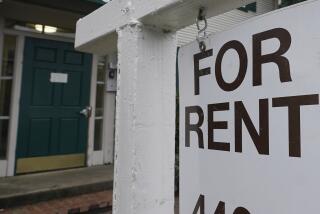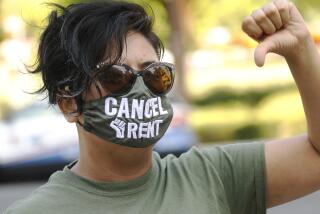Thousand Oaks Council Appears Set to Crack Down on Slumlords
THOUSAND OAKS — Taking a tougher tack toward slumlords, the City Council is considering a law that would allow code enforcers to actively seek out violations at all properties held by delinquent owners.
The City Council at Tuesday’s meeting appears poised to enact a “substandard-housing owner ordinance,” spurred by last year’s discovery of a ramshackle village in Thousand Oaks’ Old Town neighborhood near City Hall.
Council members will also consider beefing up code enforcement in two of the city’s aging neighborhoods, a swath of Old Town and the Warwick Avenue apartments--an idea they have already tentatively backed.
Coupled with the creation of a substandard-housing handbook compiling all applicable state and city housing laws in one package, the proposal suggests Thousand Oaks’ commitment to adequate housing for all, said Councilman Andy Fox.
“This is the first law of its kind in the city--a sweeping ordinance that brings together a lot of standards regarding health and safety,” said Fox, who proposed the slumlord ordinance after the shantytown cleanup last year. He resuscitated the idea a month ago, after violations were uncovered at other properties owned by the same landlords.
“My intention was to make it punitive in nature, and, hopefully through that process, it will serve as a wake-up call that . . . this type of housing will not be tolerated in Thousand Oaks,” he said.
The proposed law, however, is not tough enough to suit Councilwoman Linda Parks, who would have preferred an administrative setup similar to that in San Jose. There, the city collects daily fines until code violations are remedied, and city officials can process code violations in-house rather than having to go to court.
The new law “is certainly not the hammer I was looking for,” Parks said. “It’s a foundation, someplace to start working from, but I think we can do better.”
The proposed law would work like this:
Say you own one or more problem properties. If twice in a year code enforcers cite you for housing-rule violations that you fail to correct after receiving a “final order,” you would be dubbed a “substandard-housing owner.” Once you’re so labeled, city code enforcers can check all other properties you own, even without a neighbor complaint. Typically, code enforcers act only on complaints.
It is not clear, however, how often the new law could be used.
It would not apply, for example, to the shantytown landlords.
The reason: Although they have been cited repeatedly for code violations, the property owners have always complied with code enforcers’ cleanup orders.
While the law would be a tool, code compliance supervisor Geoff Ware could not think of a time in the last 18 months that a landlord had met the law’s criteria.
“How many people [the law] would affect is hard for me to say,” Ware said. “ . . . But are they out there? It could be that there are several people who own multiple houses that are substandard and aren’t listening to our notices. Who knows?”
Like Parks, Fox suggested that the council might need to bolster the city attorney’s suggestions for the ordinance.
The new law would not increase penalties, which, by state law, cannot exceed a $1,000 fine and six months’ jail time for misdemeanor housing violations and a $5,000 fine and a year in jail for criminal acts.
Instead, the law is meant to prod “property owners to properly manage, control and maintain their properties and to deter property owners from allowing people to live in substandard housing,” according to a report prepared by Deputy City Atty. James T. Friedl.
By making it easier for code enforcers to sniff out substandard housing, the law also opens “an important legal door for tenants,” allowing them to seek “specific legal remedy for correction of substandard housing,” Friedl wrote.
Also Tuesday, the City Council will consider a six-month pilot program for proactive code enforcement, proposed by Councilwoman Judy Lazar, which would be used on a rotating basis in the city’s older neighborhoods.
Code compliance supervisor Ware and his staff propose that the western half of Old Town--the area roughly bounded by Thousand Oaks Boulevard, Fairview Road, Auto Mall Drive and the Ventura Freeway--and the 50-unit apartment complex at 650 Warwick Avenue--be the first to receive the extra attention.
If council members agree to begin with these two areas, it would cost about $21,000 to notify homeowners and cover staffing for additional inspections.
Other areas proposed for the program include the eastern half of Old Town, the Conejo Country Homes area and the Park Terrace Apartments.
Before the additional code enforcement would begin, all property owners and tenants in the area would be notified, asked to report any particular areas of concern and told of some common code violations, including littered yards, deteriorating buildings, unsafe wiring and garages converted into living quarters.
The additional inspections--proposed to take place between June 1 and Nov. 30--are a way to encourage tenants and property owners to spiff up things on their own, Ware said.
“We’re not saying to the residents of these areas, ‘You’re bad,’ ” he said. “But these are older parts of the city, and, because of that, they’re going to show greater signs of the aging process.”
All the areas chosen have had regular maintenance complaints and have been listed as target areas in the 1985 Housing Condition Survey, the city-sponsored housing rehabilitation program or the 1997 apartment survey.
More to Read
Sign up for Essential California
The most important California stories and recommendations in your inbox every morning.
You may occasionally receive promotional content from the Los Angeles Times.










